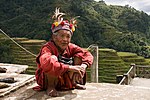This article lists the practices listed in UNESCO intangible cultural heritage to Philippines.
Understand
The country has three practices based on the "representative list of intangible cultural heritage From UNESCO.
No additional practice is included in the "register of best practices for safeguarding culture "Or on the"emergency backup list ».
Lists
Representative list
| Convenient | Year | Domain | Description | Drawing |
|---|---|---|---|---|
| 1 The Darangen epic of the Maranao of Lake Lanao | The Darangen is an ancient sung epic which conceals a real treasure of knowledge of the Maranao, a people established on the shores of Lake Lanao, in Mindanao. This island, located in the extreme south of the archipelago of Philippines, is the homeland of the Maranao, one of the country's three main Muslim groups. Comprising 17 cycles and nearly 72,000 verses, the Darangen celebrates episodes from the history of the Maranao and the tribulations of mythical heroes. Along with gripping narrative content, the epic explores fundamental themes of life and death, the art of seduction, love and politics through symbols, metaphors, irony and satire. The Darangen also conveys a code of customary law, standards of social and ethical behavior, principles of aesthetic beauty and social values specific to the Maranao. Even today, in the exercise of customary law, the elders refer to this text consecrated by custom. Darangen, which literally means "to tell while singing", existed before the Islamization of the Philippines in the fourteenth century. It is part of an epic culture linked to ancient Sanskrit traditions and widespread throughout almost the entire island of Mindanao. Although much of it has been transmitted orally, some passages have been recorded in manuscripts using an ancient Arabic writing system. It is sung at weddings, by specially trained men and women, and can last for several nights. Performers must have a prodigious memory, improvisational skills, a poetic imagination, a good knowledge of customary law and genealogy, impeccable and elegant vocal technique, as well as a definite talent for captivating an audience for long hours. . The chanting is sometimes accompanied by music and dancing. Nowadays, Darangen is performed less often, in part because of its extremely rich vocabulary and archaic linguistic forms which are only understood by practitioners, elders and scholars. In addition, the standardization of lifestyles could pose a threat to the survival of this ancient epic. |  | ||
| The Hudhud, sung tales of the Ifugao | Hudhud is a narrative song tradition of the Ifugao community, known for their system of terraced rice fields in the mountains of thenorthern island of the archipelago of Philippines. This tradition is practiced at the time of sowing and harvesting of rice, as well as during vigils and funeral rituals. Probably prior to the seventh century, the Hudhud has over 200 stories, each divided into 40 episodes. Their full recitation would span several days. As the Ifugao are of a matrilineal culture, the wife often takes the lead role in these songs and her brother has a higher rank than her husband. The language of the stories, rich in figurative expressions and repetitions, calls on metonymies, metaphors and onomatopoeias, making their transcription difficult. There are thus very few written traces of this tradition. The stories evoke ancient heroes, customary law, religious beliefs, traditional practices and reflect the importance of rice cultivation. The narrators, mostly elderly women, occupy a prominent place in the community, both as historians and priests. The hudhud epic is chanted in turn by the first reciter and by a choir, in a single melody for all stanzas. The conversion of the Ifugao to Catholicism weakened their traditional culture. In addition, the hudhud is linked to the manual harvest of rice, which is now a mechanized harvest. Although the rice terraces have been inscribed on the World Heritage List, the number of cultivators continues to decline. The last narrators, already very old, need to be supported in their efforts to pass on their knowledge and raise awareness among young people. |  | ||
| Tug of war rituals and games Note the Philippines shares this practice with the Cambodia, the South Korea, the Viet nam. | social practices, rituals and festive events knowledge and practices concerning nature and the universe | Tug-of-war rituals and games in the rice crops of East and Southeast Asia are practiced in communities to ensure bountiful harvests and prosperity. They promote social solidarity, entertainment and mark the beginning of a new agricultural cycle. Many rituals and games also have deep religious significance. Most variations have two teams, each holding the end of a rope trying to pull it to the other side. The intentionally non-competitive nature of the event removes the focus on winning or losing, asserting that these traditions are carried out to promote the well-being of communities, and reminding members of the importance of cooperation. Many tug of war games bear traces of agricultural rituals, symbolizing the strength of natural elements such as sun and rain while also associating mythological elements or purification rites. Rituals and tug of war games are often organized in front of the town hall or the village sanctuary, preceded by commemorative rites in homage to local deities. The village elders play an active role in leading and organizing the younger ones and in performing accompanying rituals. Tug of war rituals and games also serve to strengthen unity and solidarity as well as a sense of belonging and identity among community members. |  |
Register of Best Safeguarding Practices
The Philippines does not have a practice listed in the Best Safeguarding Practices Register.
Emergency backup list
The Philippines does not have a practice on the Emergency Safeguarding List.
